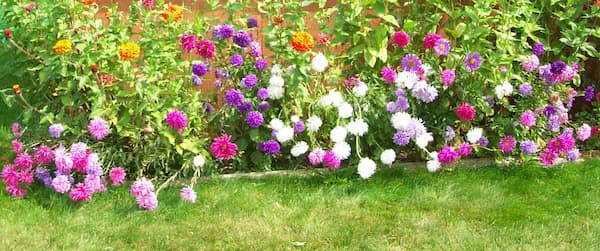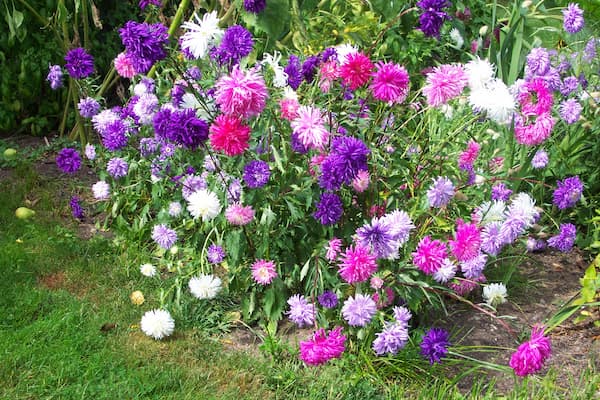How to Grow Aster Flowers

About Aster Flower Plants
Growing Aster flowers is fun and easy. The plants put on a display of bright, profuse, and long-lasting blooms. Consequently, they are popular in home gardens. With over 180 varieties, perennial aster plants are sometimes grown as annuals in colder climates. Aster flowers are a symbol of elegance and patience. Certainly, you will agree that the flowers are indeed elegant. Aster flowers grow well in average soils but need full sun. Blooms grow on erect, woody stems. The flowers are 2 inches in diameter and are wilt-resistant. Aster flowers come in blues, pinks, purples, and white. All Asters are yellow in the center of the flower. They are daisy-like in appearance, even though they are a member of the sunflower family.
Did you know? The yellow center of Asters is actually comprised of many tiny flowerets.
Asters come in a wide variety, with some less than a foot tall, while others are several feet tall. Both large and smaller varieties make good cut flowers for vases and arrangements.
Aster Plant Specifications
Flower Colors: Shades of blue, pink, purple, and white.
Flowers Bloom: Summer to Fall
Plant height: 8 inches to 8 feet, depending upon variety. Most aster plants grow up to 24 inches tall.
Light Requirements: Full to partial sun.
Ideal Soil pH: 5.5 – 7.5.
Hardiness Zone: 3 – 8
Toxicity: Safe to eat.
Native To: North America and Southern Europe
Plant Type: Perennial, sometimes grown as an annual.
Botanical Name: Symphyotrichum
Are Aster plants Edible?
Yes!
Aster leaves and flowers are edible. The roots are edible, too. Use them fresh or dried. They add color to salads. Try them in soups and stews, and on cheese trays and other dishes as an edible garnish. Often, the leaves are used in teas. Also, they are used to decorate drinks and cocktails.
Aster Plant Medicinal Applications
Ancient Chinese medicine has used this plant. There are many medicinal applications used by herbalists today.
Among them are:
- Asters have anti-inflammatory properties.
- It promotes healthy blood circulation.
- To reduce fever and inflammation.
- Treats headaches.
- Use it for stomach aches and to relieve gas pains.
Perennial Aster Plant Propagation
Asters are easily grown from division. Aster plants do best if divided every two to three years. Simply dig out half to two-thirds of the plants, leaving the remainder in place. Then separate the portion you dug out into two sections and plant in another location or give them to a friend.
Aster seeds can also be directly seeded into your flower garden or seeded indoors for transplanting later. We recommend planting Asters in pots and containers indoors, then transplanting the seedlings outdoors in early spring. This allows you to make the proper spacing.
Sow Aster seeds early in the season, and cover lightly with soil. Water thoroughly once. The seeds germinate easily and plants grow quickly, producing their first of a continual display of blooms by mid-summer.
Transplant Asters into your garden into an area where they can be grown for years. Spacing depends upon size with miniature varieties spaced four to six inches apart, and Giant varieties one to two feet apart. Place smaller varieties around the front of your flower garden as a border. Put larger varieties towards the back of the flowerbed.
Aster Seed Germination: 8 – 10 days

How to Grow Perennial Aster Flower Plants
If you are in a warmer region and are growing them as a perennial, select a location where they will remain for many years. Grow the plants in full sun. They tolerate partial shade. However, too much shade reduces the number of blooms. Aster plants will grow well in average soils. But, like all plants, they will reward you with bigger blooms and a healthier plant if you add plenty of compost at the planting site. Also, add a general-purpose fertilizer once a month.
Once your perennial Aster plants are established, they should grow well for years. The s0il should be moist, but not wet. They will withstand dry periods. Water them during dry periods, once or twice per week to keep growth vibrant. It is important to water them at the base of the plants. Water on the leaves encourages the growth of molds and fungus.
Add mulch around the plants for appearance and to keep weeds down. As the mulch breaks down, it feeds the plant.
Around mid to late summer, your plants will begin to produce flowers and will continue to do so until frost.
In colder regions, you can over-winter the plants. Dig them up and put them into a flowerpot or other suitable container. Add water to the soil to make it just slightly moist. Then, put them in a cold frame, or an unheated greenhouse or garage.
Pruning Aster Plants
You do not need to remove dead flower blooms, except to improve plant appearance. Also, pruning helps the pants to grow better and healthier. For giant varieties, trim back any stalks that have become gangly or unsightly. And as always, prune off any dead or sick branches and leaves. Additional pruning to thin out dense areas improves air circulation and helps to avoid plant disease.
Aster Cuttings for Indoor Arrangements
Asters have sturdy stalks that make them good candidates for flower vases and other indoor arrangements. Cut the stem low, check for insects hiding in the flower, on the stem, and under the leaves. Bring them indoors and place them in water immediately.
For smaller varieties, simply use a small container or vase. Cut the stem a couple of inches long. Bunch up a variety of colors for an eye-appealing arrangement. Add a small sprig or two of Baby’s Breath.
Remember Asters, when creating container gardens for your deck or porch. They are excellent candidates. Use varieties with a shorter growth habit.
Insects and Plant Disease
Perennial Asters are somewhat resistant to insects and disease. If insect or disease problems occur, treat them early with organic or chemical insect repellents and fungicides.
Also see: Plant Problems – causes and cures.
Please support our site. Shop for:
- rmmatthews100@hotmail.com
- 585-721-6528
- Rochester, NY
©1999-2024 GardenersNet.Com, All Rights Reserved

